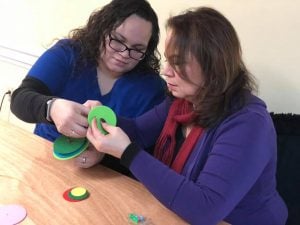Art and other complementary therapies for Parkinson’s disease
A growing number of people with Parkinson’s disease (PD) are interested in trying to improve both their motor and non-motor symptoms with therapies that are not medications. Beyond physical, occupational and speech therapy, all of which can play a crucial role in maximizing function in PD, there are a vast array of available complementary therapies. These include:
-
Exercise/movement
- Boxing
- Dance including tango
- Yoga
- Tai chi and Qigong
-
Mindfulness techniques
- Meditation
-
Manual practices
- Acupuncture
- Massage
-
Creative pursuits
- Singing/choir
- Music therapy including auditory cueing
- Dance including tango
- Theater
- Art therapy
Many of these therapies have been studied formally in PD, although usually in only small groups of people. Therefore, much is unknown about whether these therapies are truly effective and if so, how they work and how to maximize their benefit. Complementary therapy for PD is a large topic to cover and I will write more than one blog on this subject. Today, let’s focus on art therapy.
Parkinson’s and Art Therapy
Although data has been accumulating to support the use of many complementary therapies in PD, data for use of art therapy has lagged behind. According to the American Art Therapy Association, art therapy uses “art media, the creative process, and the resulting artwork to explore feelings, reconcile emotional conflicts, foster self-awareness, manage behavior and addictions, develop social skills, improve reality orientation, reduce anxiety and increase self-esteem.”
The definition of art therapy could potentially be expanded even further to include art therapy as a means towards neurologic and mental health improvement. Although many of these elements would substantially benefit people with PD, art therapy has not been rigorously studied in clinical trials to determine whether it can actually bring about these clinical improvements. The lack of data in this case, however, may simply mean that the trials have not yet been done.
Vision issues and art therapy
It is well known that vision issues can be prominent in PD. This includes difficulty with visuospatial perception (the ability to perceive spatial relations in the environment.) Poor visuospatial skills affect depth and distance perception as well as navigational skills, which can directly translate into difficulty with activities such as reading, driving, and even walking. As visuospatial challenges increase, so do gait dysfunction and falls.
Problems in a number of eye and brain areas affected by PD can contribute to these difficulties including the retina, the eye movement apparatus and the thinking parts of the brain that process vision and integrate it with other cognitive functions.
Exploring how art therapy may help PD
Currently, rehabilitative strategies in PD do not typically address visuospatial deficits, and this may hamper how much improvement a person can expect from his/her therapy. Whether art therapy, through art creation, can improve these deficits is a promising avenue of investigation. A study underway at the Marlene and Paolo Fresco Institute for Parkinson’s & Movement Disorders at NYU Langone in New York City exploring the effects of art therapy on visuospatial deficits was recently described .
Art and PD: Beyond the physical benefits
Art therapy may also be a tool that enhances the lives of people with PD more generally. One small study investigated clay art in people with PD and showed improvements in hand dexterity, mood, and quality of life. More studies are necessary to determine whether these effects are clinically relevant and if so, to define the optimal type and duration of the therapy.
Also, despite the visuospatial challenges of some people with PD, there is evidence that people with PD might experience an increase in creativity, or even develop a new interest in creative pursuits with their diagnosis, possibly fueled by dopaminergic medications. An increase in creativity can also accompany other neurologic disorders, unrelated to dopaminergic medication. Therefore, the possibility exists that PD alone can fuel creativity, perhaps in combination with the effects of PD meds.
An increased drive to create coupled with potential neurologic improvement from art creation may lead to an enhanced focus on art therapy for PD in upcoming years.
APDA’s Connecting Through Art
Photo Credit: Smile Through Art Workshops
Even before definitive studies are done to evaluate the benefits of art therapy in PD, people with PD find happiness, satisfaction, socialization and camaraderie in artistic pursuits.
APDA is excited to announce a new national program being piloted in 2019, called Connecting Through Art. This program will foster the incorporation of art into the lives of people living with PD and encourage socialization through a series of creative activities.
The first activity to be offered through this program will be an art class with the instruction provided by The Art Cart’s Smile Through Art™ workshop, which offers people with PD the ability to express feelings, emotions and concerns regarding PD through the activity of painting/drawing.
APDA is thankful to Acorda Therapeutics for sponsoring this program. Classes are being organized now, so stay tuned to find out if your local APDA Chapter or Information and Referral (I&R) Center will be offering one. You can use this navigator tool to find an APDA chapter or I&R Center near you.
It may take scientists more time to discover all the relationships between art, art therapy and PD. Until then, feel free to explore your inner creativity!
Tips and Takeaways
- Many complementary therapies are available for PD that may be helpful for different PD motor and non-motor symptoms. More studies are necessary to improve our understanding of their use in PD.
- Art therapy may enhance visuospatial skills and a study is now underway to further evaluate that connection.
- Regardless of potential physical benefits, many people with PD report emotional and social benefits from art-related activities.
APDA is launching a Connecting Through Art pilot program to bring art creation as a therapeutic tool to the APDA community.

